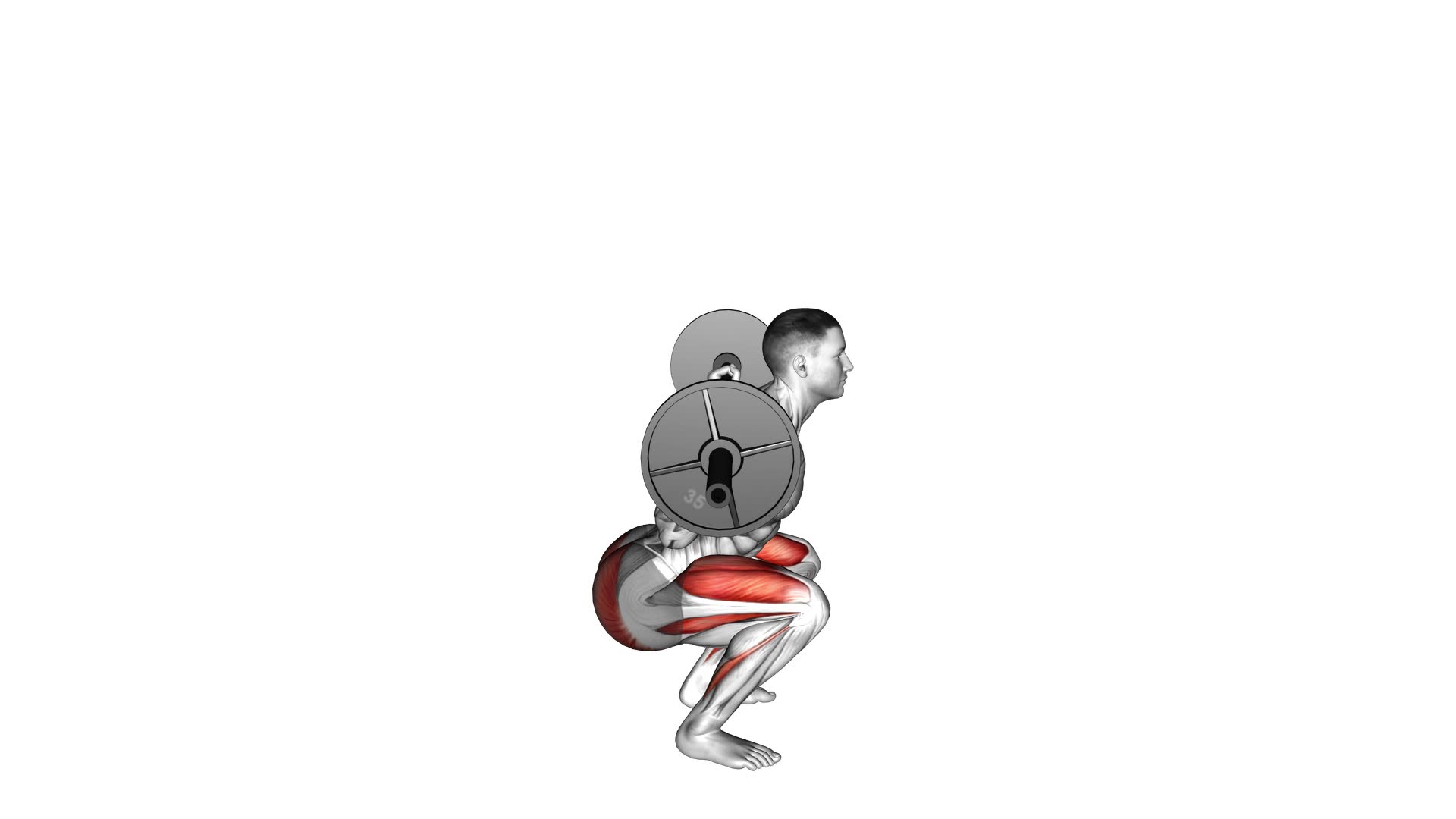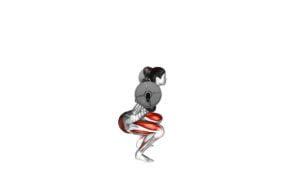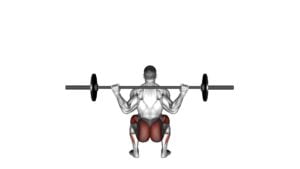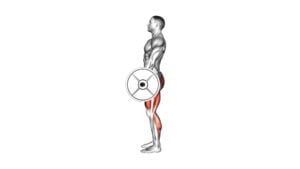Barbell Full Squat (Side POV) – Video Exercise Guide & Tips

In this guide, you'll learn how to perform the barbell full squat with proper form and technique.
Watch This Exercise Video
This exercise is highly effective for building leg and glute strength, improving overall lower body stability, and increasing muscle mass.
Avoid common mistakes and discover progression and variation options to challenge yourself further.
With tips on increasing resistance and intensity, you'll be able to maximize your workout and achieve your fitness goals.
Get ready to squat like a pro!
Key Takeaways
- Barbell Full Squat is highly effective for building leg and glute strength.
- Proper form and technique include maintaining a strong core, squatting until thighs are slightly below parallel, and keeping knees aligned with toes.
- Common mistakes to avoid include improper alignment of knees with toes, allowing knees to cave inwards, and rounding the lower back.
- Progression and variations, such as Bulgarian Split Squat and Front Squat, can be incorporated to target different muscles and keep workouts effective.
Benefits of Barbell Full Squat
You can experience increased lower body strength and improved overall stability through the benefits of performing the Barbell Full Squat. This exercise is highly effective in activating and strengthening the muscles of your lower body, including your quadriceps, hamstrings, glutes, and calves. The full squat movement engages these muscles to a greater extent compared to other lower body exercises, leading to increased muscle activation and development.
One of the key advantages of the Barbell Full Squat is its ability to improve athletic performance. By strengthening the muscles involved in lower body movements, such as jumping, sprinting, and changing direction, you can enhance your speed, power, and agility. The increased lower body strength gained from this exercise translates into improved performance in sports like basketball, soccer, and track and field.
Furthermore, the Barbell Full Squat also promotes better stability and balance. As you lower your body into a deep squat and then rise back up, you engage the stabilizing muscles of your core, hips, and ankles. This not only improves your overall balance but also helps prevent injuries by strengthening these important areas.
Proper Form and Technique
To achieve proper form and technique for the Barbell Full Squat, focus on maintaining a strong and stable core throughout the exercise. This will help you engage your abdominal muscles and protect your spine.
One common misconception is that you should only squat down until your thighs are parallel to the ground. However, to fully engage your muscles and maximize the benefits of this exercise, aim to squat down until your thighs are slightly below parallel. This deeper squat will activate your glutes, hamstrings, and quadriceps more effectively.
Additionally, it's important to keep your knees aligned with your toes as you squat down. Avoid letting your knees collapse inward, as this can put unnecessary strain on your joints.
For advanced modifications, you can try adding weight to the barbell to increase the intensity of the exercise. Start with a weight that challenges you but allows you to maintain proper form. You can also incorporate pauses at the bottom of the squat to increase time under tension and further engage your muscles. However, be mindful of your form and avoid sacrificing it for additional weight or depth.
Common Mistakes to Avoid
One common mistake to avoid when performing the Barbell Full Squat isn't maintaining proper alignment of the knees with the toes. This misalignment can put excessive stress on the knees and lead to injury. To prevent this, make sure your knees are tracking in the same direction as your toes throughout the movement.
Another common pitfall is allowing the knees to cave inwards during the squat. This places additional strain on the knee joint and can increase the risk of injury. To avoid this, focus on pushing your knees outwards as you squat down.
Additionally, it's important to avoid rounding your lower back during the squat. This can lead to strain on the spine and increase the risk of injury. To maintain proper form, engage your core and keep your back straight throughout the movement.
Progression and Variations
To enhance your Barbell Full Squat workout and continue challenging your muscles, there are several progressions and variations you can incorporate.
Adding these modifications to your routine will help you achieve better results and prevent plateaus.
One progression you can try is the Bulgarian Split Squat. This exercise targets your quads, glutes, and hamstrings even more than the traditional squat. To perform it, place one foot on a bench or step behind you, and squat down with the other leg. This unilateral movement forces each leg to work independently, increasing the difficulty and requiring more stability.
Another variation is the Front Squat, where you position the barbell in front of your shoulders instead of on your upper back. This shift in weight distribution places more emphasis on your core and upper body, providing a different challenge for your muscles.
If you're looking for advanced modifications, consider trying the Pistol Squat or the Jump Squat. The Pistol Squat is a single-leg squat that requires great strength and balance. The explosive movement of the Jump Squat adds plyometric benefits to your workout, increasing power and explosiveness.
Incorporating these progression variations and advanced modifications into your Barbell Full Squat routine will keep your workouts exciting and effective. Remember to always practice proper form and gradually increase the difficulty to avoid injury.
Tips for Increasing Resistance and Intensity
To maximize the effectiveness of your Barbell Full Squat workout, consistently increase the resistance and intensity by gradually adding more weight or performing more repetitions.
Here are three tips to help you increase the resistance and intensity of your Barbell Full Squat:
- Gradually increase the weight: As you become stronger and more comfortable with the exercise, gradually increase the weight you're lifting. Start with a weight that challenges you but allows you to maintain proper form. Then, add small increments of weight over time to continue challenging your muscles and promoting growth.
- Incorporate advanced modifications: Once you have mastered the basic Barbell Full Squat, you can incorporate advanced modifications to increase the resistance and intensity. Some examples include performing the exercise on an unstable surface, such as a Bosu ball, or using resistance bands to add extra tension to the movement.
- Focus on tempo and time under tension: To further increase the intensity of your Barbell Full Squat, pay attention to the tempo of your repetitions and aim to increase the time under tension. Slow down the lowering phase of the squat and pause at the bottom before exploding back up. This will challenge your muscles more and promote greater strength gains.
Frequently Asked Questions
How Often Should I Incorporate Barbell Full Squats Into My Workout Routine?
Incorporating barbell full squats into your workout routine can be highly beneficial. They're a compound exercise that targets multiple muscle groups, including your quads, glutes, and hamstrings. By regularly performing this exercise, you can increase lower body strength, improve overall stability, and enhance your athletic performance.
It's recommended to include barbell full squats in your routine at least 2-3 times a week, allowing for proper rest and recovery between sessions.
Can Barbell Full Squats Help Improve My Athletic Performance in Other Sports?
Barbell full squats can significantly improve your athletic performance in other sports. By engaging multiple muscle groups, they enhance your overall strength, power, and explosiveness.
This exercise also improves your lower body stability and balance, which are crucial for sports like basketball, soccer, and tennis.
Additionally, barbell full squats can boost your vertical jump and sprinting speed, giving you a competitive edge on the field or court.
Incorporating them into your routine will yield numerous benefits for your sports performance.
Are There Any Specific Warm-Up Exercises or Stretches I Should Do Before Attempting Barbell Full Squats?
Before attempting barbell full squats, it's important to warm up properly to prevent injury and optimize performance.
Incorporate warm-up exercises like jumping jacks, lunges, and leg swings to increase blood flow and prepare your muscles for the workout.
Additionally, include stretching techniques such as quadriceps, hamstring, and calf stretches to improve flexibility and range of motion.
These warm-up exercises and stretching techniques will help you get the most out of your barbell full squat routine.
What Are Some Alternative Exercises That Can Be Done to Target the Same Muscles as Barbell Full Squats?
To target the same muscles as barbell full squats, there are alternative exercises you can try. Bulgarian split squats and goblet squats are two effective options. These exercises engage the quads, glutes, and hamstrings, just like barbell full squats.
Bulgarian split squats focus on single-leg strength and stability, while goblet squats target the lower body muscles while also engaging the core.
Adding these exercises to your routine can help you achieve similar results to barbell full squats.
Can Barbell Full Squats Help With Weight Loss or Body Composition Changes?
Barbell full squats are a great exercise for muscle building. They can also be beneficial for weight loss and body composition changes. By incorporating barbell full squats into your weight loss program, you'll engage multiple muscle groups and burn calories.
This exercise helps increase your overall strength and boosts your metabolism, leading to more efficient fat burning. So, if you're looking to maximize your weight loss efforts and improve your body composition, give barbell full squats a try.
Conclusion
In conclusion, the barbell full squat is a highly beneficial exercise for building strength and muscle in the lower body. By maintaining proper form and technique, you can maximize the benefits and avoid common mistakes.
Progression and variations can help you continually challenge yourself and prevent plateaus.
Lastly, increasing resistance and intensity over time will help you achieve your fitness goals. Incorporate this exercise into your routine for a powerful lower body workout.

Author
Years ago, the spark of my life’s passion ignited in my mind the moment I stepped into the local gym for the first time. The inaugural bead of perspiration, the initial endeavor, the very first surge of endorphins, and a sense of pride that washed over me post-workout marked the beginning of my deep-seated interest in strength sports, fitness, and sports nutrition. This very curiosity blossomed rapidly into a profound fascination, propelling me to earn a Master’s degree in Physical Education from the Academy of Physical Education in Krakow, followed by a Sports Manager diploma from the Jagiellonian University. My journey of growth led me to gain more specialized qualifications, such as being a certified personal trainer with a focus on sports dietetics, a lifeguard, and an instructor for wellness and corrective gymnastics. Theoretical knowledge paired seamlessly with practical experience, reinforcing my belief that the transformation of individuals under my guidance was also a reflection of my personal growth. This belief holds true even today. Each day, I strive to push the boundaries and explore new realms. These realms gently elevate me to greater heights. The unique combination of passion for my field and the continuous quest for growth fuels my drive to break new ground.







